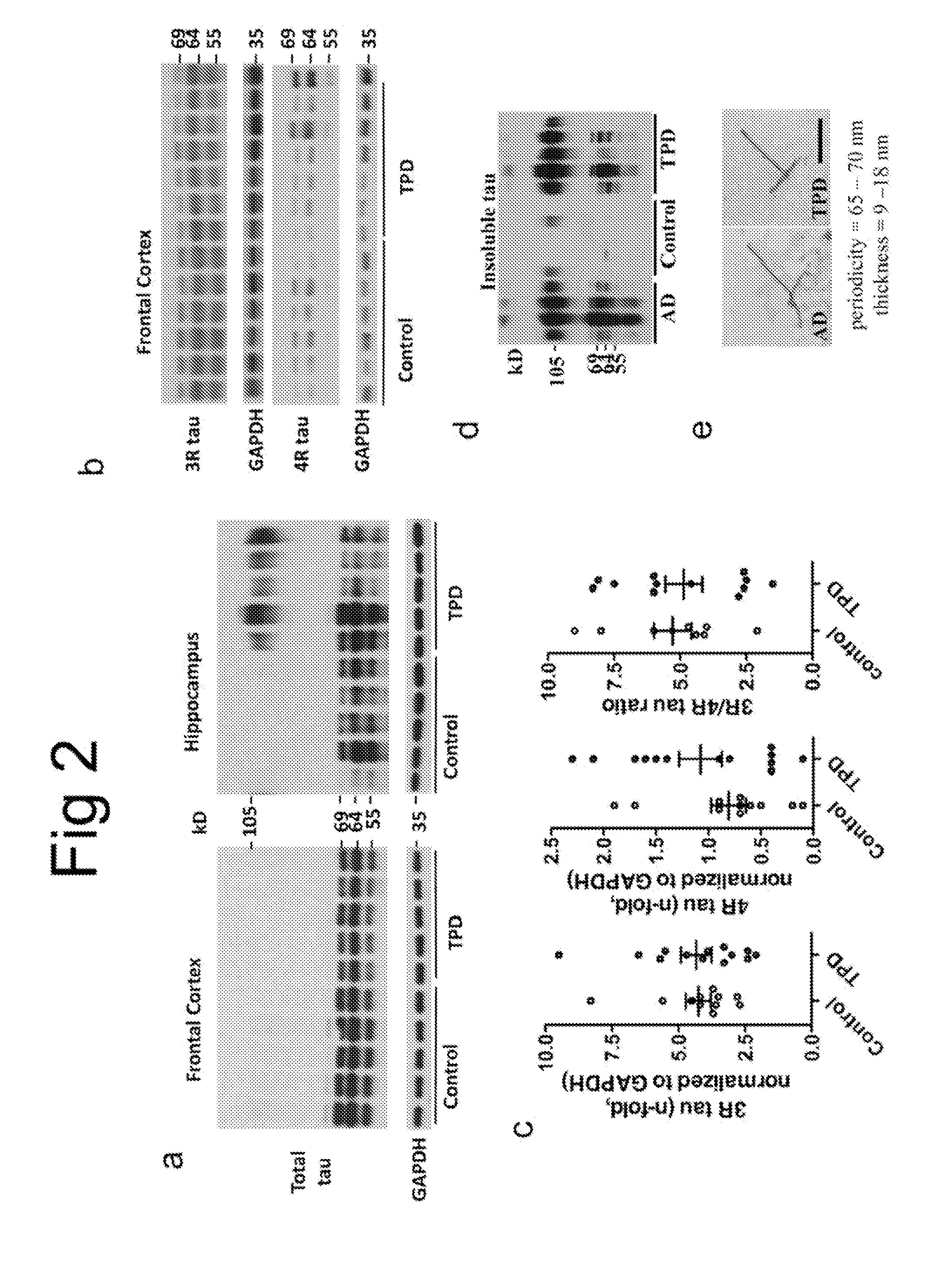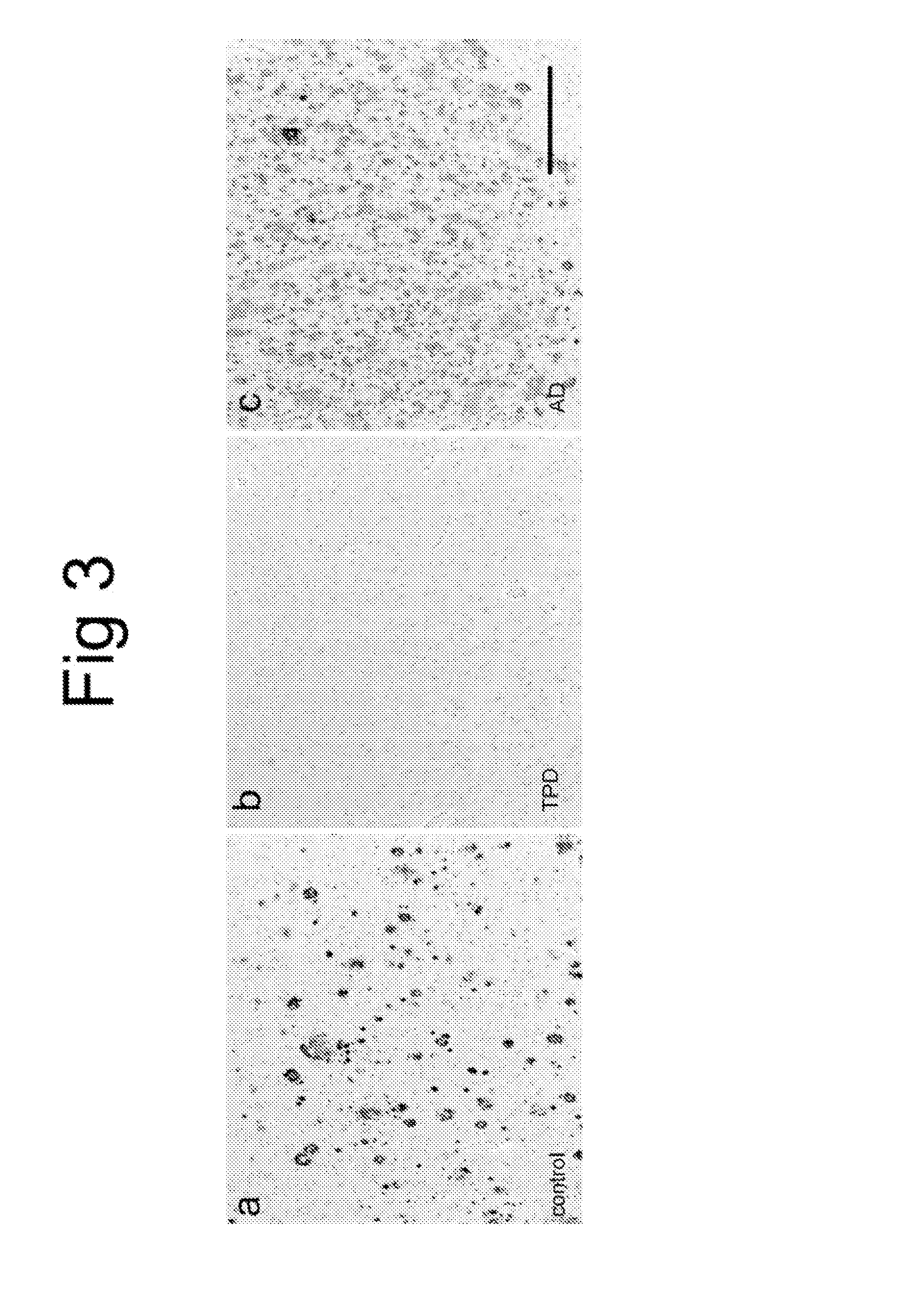Biomarkers for tangle-predominant dementia
a biomarker and dementia technology, applied in biochemistry apparatus and processes, instruments, material analysis, etc., can solve the problems of low soluble a, low soluble a, and unclear relationship between amyloid plaques and neurofibrillary degeneration in ad, and achieve low levels of soluble a
- Summary
- Abstract
- Description
- Claims
- Application Information
AI Technical Summary
Benefits of technology
Problems solved by technology
Method used
Image
Examples
example 1
Patient Samples and Statistical Analysis
[0244]Autopsy brain samples were obtained from seven centers (Table 1). The primary source of material was the brain bank at Columbia University Medical Center (CUMC) (New York, N.Y.) (Tables 2 and 3). Secondary sources were the University of California San Diego (San Diego, Calif.), the University of Kentucky (Lexington, Ky.), the Banner Health Banner Sun Health Research Institute (Sun City, Ariz.), Northwestern University (Chicago, Ill.), the University of Washington (Seattle, Wash.) and Washington University (St. Louis, Mo.). Patient data for each component of this study are summarized in Table 4. Neuropathological examination was per the protocols of the respective institutions.
[0245]Inclusion criteria for TPD were: 1) frequent NFT corresponding to Braak NFT stage III-IV (Braak et al. (1993)) and no or very rare NFT in the frontal, parietal or occipital cortex; 2) no more than sparse amyloid plaques (CERAD (Mina et al. (1991)) score 0 or A...
example 2
Neuropathological Analysis
[0249]Materials and Methods
[0250]Patient material from Columbia University was subjected to a detailed neuropathological analysis (Tables 2 and 3).
[0251]Immunohistochemistry was performed on 6 μm paraffin-embedded sections as previously described (Crary et al. (2006)), using various antisera found in Table 5.
[0252]For transmission electron microscopy, a portion of CA1, previously fixed in 10% neutral-buffered formalin, was post-fixed with 2.5% glutaraldehyde in 0.1 M Sorenson's buffer (pH 7.2) followed by 1% OsO4 in Sorenson's buffer for one hour and embedded in Lx-112 (Ladd Research Industries, Inc.). 60 nm sections were stained with uranyl acetate and lead citrate and examined under a JEOL JEM-1200 EXII electron microscope and imaged using an ORCA-HR digital camera (Hamamatsu Photonics, Japan).
[0253]Results
[0254]A consecutive brain autopsy series of 992 patients performed at Columbia University Medical Center was retrospectively reviewed. Of the 336 patie...
example 3
Biochemical Analysis of Tau
[0258]Materials and Methods
[0259]For biochemical analysis of tau, protein extracts were prepared from the Brodmann area 9 (BA9) of the frontal lobe, and CA1, of fresh-frozen human brain from patients in the expanded cohort described in Example 1 as described by Takahashi et al. (2002) with modifications. Briefly, fresh-frozen brain tissue was homogenized using 10 volumes (wt / vol) of extraction buffer containing 20 mM (4-[2-hydroxyethyl]-1-piperazineethanesulfonic acid]) (HEPES), pH 7.4, 100 mM NaCl, 20 mM NaF, 1% Triton X-100, 1 mM sodium orthovanadate, 5 mM EDTA containing a Complete Mini protease inhibitor cocktail (Roche Applied Science, Indianapolis, Ind.) supplemented with 2 mM PMSF using 15 strokes with a Teflon-coated pestle. Homogenates were centrifuged at 3000×g at 4° C. for 5 minutes. The supernatant (crude total tau fraction) was aliquoted and stored at −80° C.
[0260]Preparation of sarkosyl-soluble and insoluble fractions was carried out as descr...
PUM
| Property | Measurement | Unit |
|---|---|---|
| Biological properties | aaaaa | aaaaa |
Abstract
Description
Claims
Application Information
 Login to View More
Login to View More - R&D
- Intellectual Property
- Life Sciences
- Materials
- Tech Scout
- Unparalleled Data Quality
- Higher Quality Content
- 60% Fewer Hallucinations
Browse by: Latest US Patents, China's latest patents, Technical Efficacy Thesaurus, Application Domain, Technology Topic, Popular Technical Reports.
© 2025 PatSnap. All rights reserved.Legal|Privacy policy|Modern Slavery Act Transparency Statement|Sitemap|About US| Contact US: help@patsnap.com



